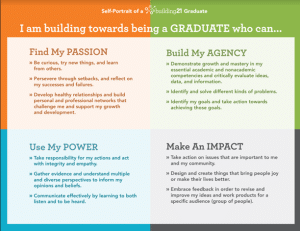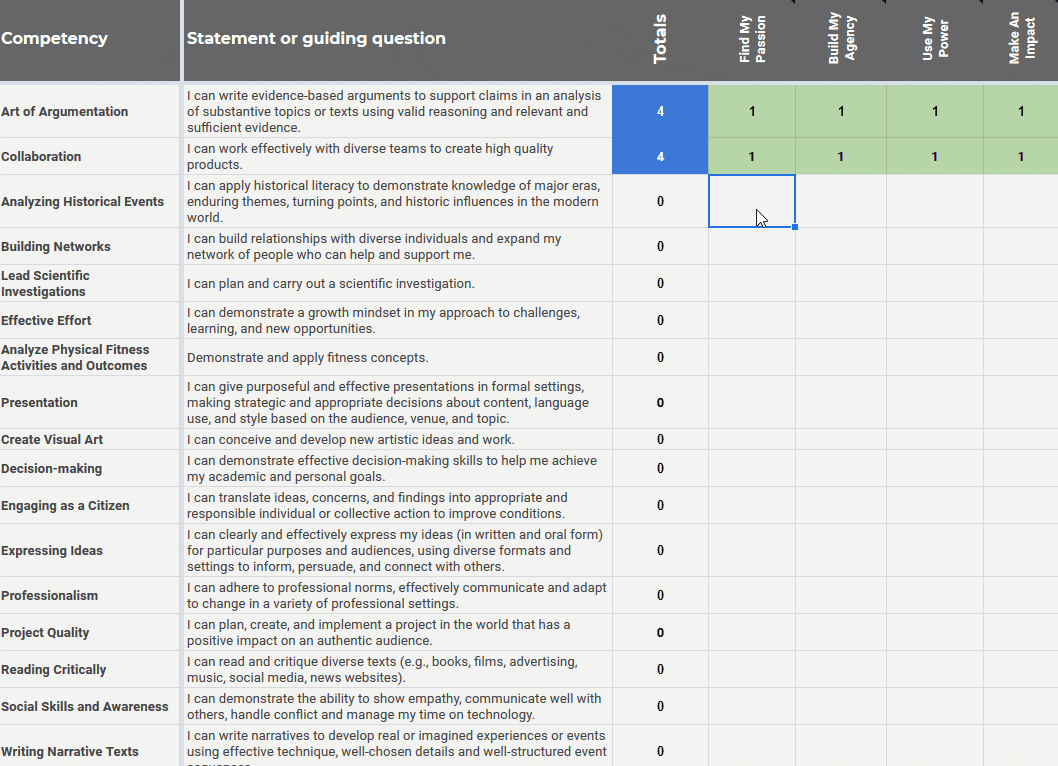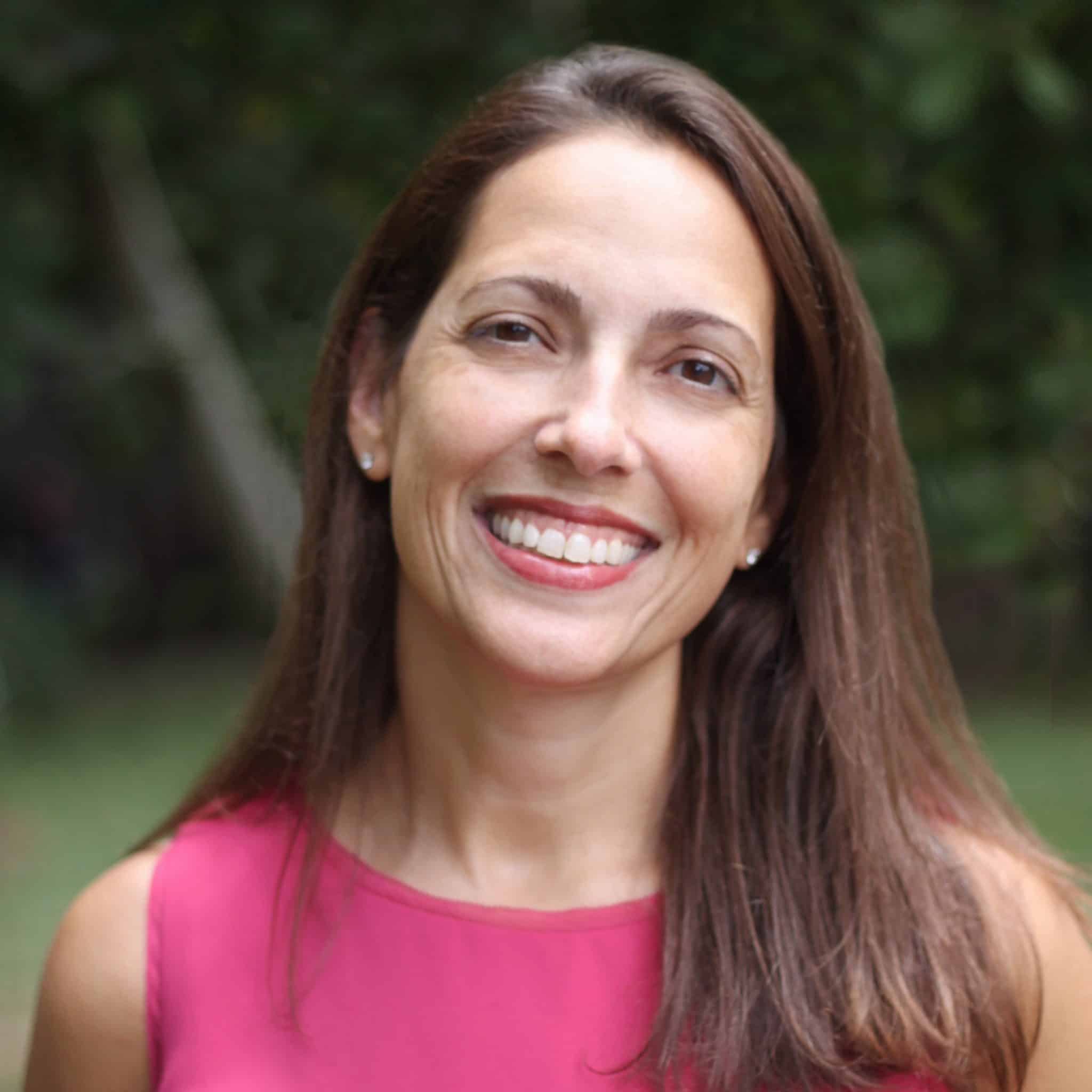Preparing for Your Competency-Based Education Journey: A Process for Success
CompetencyWorks Blog
This is the second post in a series by Sandra Moumoutjis, Executive Director of Building 21’s Learning Innovation Network. Links to the other posts are at the end of this article.
Before you begin your journey to competency-based education, you need to prepare for this change. I use the word “journey” intentionally, because it evokes a sense of a lengthy trip that will require you to overcome obstacles and struggles but is well worth the effort. Just like with any journey, you need to pack the right gear, know what tools you need to get you to your destination, and have knowledgeable and supportive people by your side. The better prepared you are and the more support you have, the more likely you will be to successfully complete your journey. So how do you best prepare for this change?
You are probably familiar with the saying, “change is a process not an event”—but for some reason we still think change should be immediate. It is not through one professional development session or one community meeting that lasting change will occur. Change is also uncomfortable for many people, even when they believe things must change. Resistance to change is inevitable and occurs for many reasons. Most often, I find that people resist change because they don’t understand why the change is occurring and they don’t feel part of the process.
For this journey to be successful, you must include your stakeholders in the process, unite your community around an understanding of the “why,” and create a shared vision for how, together, you can redefine the grammar of schooling to meet the needs of all your learners. It is essential to create a way to transparently manage and communicate this change process.
Here is an overview of Building 21’s process to help you get started:
The Why: Change always starts with why. Clearly communicate why you want to transition to competency-based education and why this is right for your community. Share data, research, student stories, and anecdotes so that people can connect and relate to the challenges and opportunities for improvement that drive your desire for change. Some schools we work with share data regarding the high number of graduates who must take remedial courses in college or drop out of college because they weren’t prepared. Others have data that point to community employers not being able to hire graduates because they cannot pass required tests or lack important nonacademic skills like collaboration and professionalism.
- Key Questions: Why are you transitioning to CBE? What is the problem you are trying to solve and how will CBE help you solve it? What data and research do you have to support the need for this change?
The Stakeholders: From the beginning, involving members from all your stakeholder groups in the change management process is essential. You need to create a shared understanding of the why and a shared vision for the impact the change will have on your community. Intentionally involving stakeholders in the process will help spread your message to a wider community and build the buy-in and support that you will need along the way. For one of our schools, an active and vibrant advisory council comprised of business and community leaders has been integral to their success.
- Key Questions: Who are all the stakeholders you need to involve in the process (e.g., leadership, teachers, students, families, community members, business leaders)? Throughout the process, how will you communicate clearly to your stakeholders and create ways for them to engage and give feedback along the way?
The Vision: Work with your stakeholders to identify what the vision is for the students in your school or district. To do this, many of our schools and districts create a Portrait of a Graduate that identifies the key qualities, skills, and mindsets that all students need to be successful in the world we live in today. This vision of a successful graduate becomes the north star for stakeholders and practitioners alike. At Building 21, our theory of action is Passion + Power + Agency = Impact; therefore, our Self-Portrait of a Graduate is aligned to this theory and is student facing:

- Key Questions: What do you want all your students to know and be able to do when they graduate? Who do you want them to be?
The Outcomes: Once you have set your vision and developed your Portrait of a Graduate, how will you know if students have achieved those qualities, skills, and mindsets? How are you measuring your desired outcomes? In our coaching work, we take stakeholder groups through a process of aligning competencies to their Portrait of a Graduate. We went through this process as well to make sure our Portrait of a Graduate was meaningful, measurable, and attainable. We already had a set of competencies that we were implementing, so we created a spreadsheet to map our current competencies to our Portrait of a Graduate. If the competency measured the characteristic, we put a 1 in the box. We then tallied up all of the 1’s to determine which competencies were most aligned to our Portrait of a Graduate and to see if we had any gaps. This helped us to identify the school wide competencies that we wanted to incorporate in our instructional design across all of our students’ learning experiences to ensure they had many opportunities to master these qualities, skills, and mindsets by the time they graduate. Here is an example of our mapping process:

- Key Questions: What are the outcomes you hope to achieve? How will you know if students have achieved your Portrait of a Graduate? What are the competencies that define learning and mastery of those qualities, skills, and mindsets?
The Timeline: Creating an initial timeline helps with managing expectations. Acknowledging that the timeline will need to be adjusted throughout implementation, it is important for the team to think about the milestones for this work and set some target dates. Some of your early milestones might include convening a CBE stakeholder group and setting dates for meetings; finalizing your Portrait of a Graduate; choosing competencies aligned to the Portrait of a Graduate; and supporting teachers in designing a performance-based assessment aligned to one competency. As part of the implementation of your timeline, each milestone will need a plan with “stepping stones” (or subtasks) to outline the process. Keep in mind as you build this timeline, you need to go slow and to be intentional—this is a marathon, not a sprint. Taking the time to establish your shared why, build your vision of success with your stakeholders, and define a set of outcomes to measure your progress towards that vision is crucial to your success. And taking the time to build out the process for each milestone along the way will ensure you have a clear picture of just how long this journey will take.
- Key Questions: How long will it take to implement this change? What are the key milestones along the journey and what are the tentative dates for completing them?
The Metrics: Deciding how you will measure successful implementation along the way will help you to communicate progress to all your stakeholders. Defining metrics will also inform adjustments that need to be made to your timeline and implementation plans. For example, if you want to improve the quality of student work aligned to the competencies, regularly engaging your staff in a student work norming protocol will allow you to measure student growth and progress on the competencies.
- Key Questions: How will you measure success along the way? What are the metrics you will use to measure success and communicate progress with stakeholders?
The Impact: Defining the longer-term impact that transitioning to CBE will have on your community helps stakeholders to stick with the journey. You can define specific metrics around your impact in areas such as increasing the number of students who achieve their postsecondary goal, improving college persistence rates, and/or increasing the number of students in your district hired by local businesses.
- Key Questions: What will the impact of transition to CBE be for students, families, teachers, and the community? What will be achieved through successful implementation of CBE?
The Struggle: We know this work is hard and that it’s essential to plan for failure and pushback. You will struggle and people will challenge the need for change again and again. Changing the grammar of schooling is no small feat, but creating a learning environment that meets the needs of all learners is worth the struggle—every minute of it. The words of Dr. Martin Luther King, Jr. capture this best:
Change does not roll in on the wheels of inevitability, but comes through continuous struggle.
- Key Questions: What will you do when things get hard to not go back to the way things have always been? How will you continue to engage your stakeholders so that they are partners in problem solving and figuring out the way forward? What resources are available to help you when you get stuck?
Your journey to CBE begins now, so start preparing. Gather your stakeholder support, clearly articulate your why, prepare everyone for the long road ahead, and create that shared vision so no matter the obstacles or struggles you face, you will persevere, undaunted and collectively committed to realizing a more equitable and student-centered grammar of schooling.
Learn More (other posts in this series)
- Why Should Schools Transition to Competency-Based Education?
- Building 21’s Teacher Competencies to Facilitate Competency-Based Learning
- Building 21’s Leadership Competencies to Facilitate Competency-Based Learning
- Building 21’s Studio Model: Designing Learning Experiences for Engagement and Impact
- Replacing the Grammar of Schooling with Competency-Based Innovations
 Sandra Moumoutjis is the Executive Director of Building 21’s Learning Innovation Network which is designed to grow and support a community of schools and districts as they transition to competency-based education. Through professional development and coaching, Sandra supports schools and districts in all aspects of the change management process. Sandra is the co-designer of Building 21’s Competency Framework and instructional model. Prior to working for Building 21, Sandra was a teacher, a K-12 reading specialist, literacy coach, and educational consultant in districts across the country.
Sandra Moumoutjis is the Executive Director of Building 21’s Learning Innovation Network which is designed to grow and support a community of schools and districts as they transition to competency-based education. Through professional development and coaching, Sandra supports schools and districts in all aspects of the change management process. Sandra is the co-designer of Building 21’s Competency Framework and instructional model. Prior to working for Building 21, Sandra was a teacher, a K-12 reading specialist, literacy coach, and educational consultant in districts across the country.